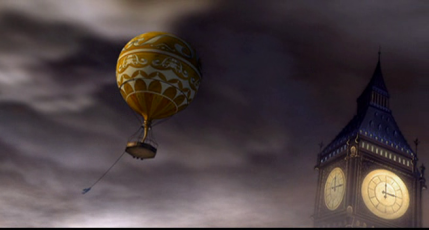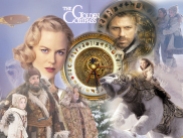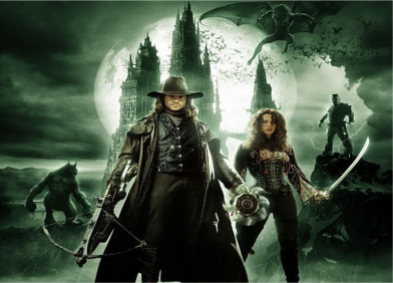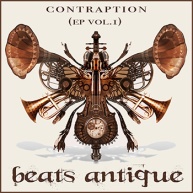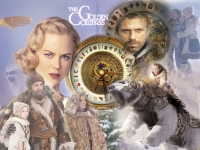Warring Worlds and Grinding Gears – a Beginners Guide to Steampunk Wargames (Andrew Knighton Guest Post #3)
Despite their destructive theme, tabletop wargames are full of creativity, from the professionals writing rules and sculpting miniatures through to the enthusiasts building terrain and painting figures. Whether you want to play at steam powered warfare, or just collect wild and fascinating toys, then there’s a steampunk wargame option for you.
Pop Sculpture – the Miniatures
Like pop music and self-publishing, wargames miniatures are the sort of art that has often been sneered at by high-brow culture. But the existence of the Beatles and Hugh Howie show just how misguided that sneering can be. As Patrick Stuart has argued on HiLoBrow, wargames miniatures are a form of pop sculpture, and one that allows more engagement by the audience than traditional sculpture. These tiny statues are designed to be modified, for you to change them through painting or conversion, to feel them in your hand, to play with them. The best are things of incredible artistry, especially in their tiny details, and they invite you to join in the creation, not just to stand and stare.
Boy is there a lot to stand and stare at. Infamy Miniatures have a growing range of steampunk figures, punking up everyone from Nikola Tesla to a monstrous Mr Hyde, with a gun-toting Oscar Wylde on the way. Demented Games have a wheeled version of Dickens’s Dodger. Artizan Designs have masked and sinister policemen. Games Workshop have several steampunk figures in their fantasy range, including the dwarf gyrocopter and the spectacular Empire Steam Tank.
If you want to collect tiny steampunk statues, then miniatures manufacturers have you covered. Just follow a few links, pick something you like, and start collecting.
Bring on the Battles
What about the games themselves?
The most popular steampunk wargame is Privateer Press’s Warmachine. Set in the steampunk fantasy world of the Iron Kingdoms, its armies centre around massive steampowered war robots guided by magical warcasters. You can play as a Soviet-style empire, religious fanatics, or even piratical freebooters, each with their own distinct steampunky aesthetic. For someone new to wargaming, Warmachine has two big advantages. It scales well, letting you start out small, and there are lots of players so you can find someone to learn with – just ask at your local gaming shop or on Privateer Press’s online forums.
The downside of Warmachine is that its rules are built around a particular brand of miniatures. If you want to collect a wide range of steampunk soldiers then there are plenty of other options. Military history publishers Osprey have a set of steampunk rules designed for small scale skirmishes – again ideal for a beginner.
The Joy of Making
“But I already have plenty of steampunk in my life,” I hear you cry. “Why bother with wargames?”
I’ll give you three answers.
The first is that you might not want to bother. After all, you could be working on your costume. But you were interested enough to read this far, so hopefully that answer isn’t the one you’re after.
The second reason is the one that applies to anything steampunky – because you can never have too much steampunk. And with wargames miniatures taking up so little space, why not fit a few into your life?
But the real reason is the third one – because wargames, like all the best steampunk activities, let you be creative. They let you take things that are already in the world and turn them into cooler things. Maybe you’ll buy an awesome miniature and make it even more awesome by painting it in your favourite colour scheme. Maybe you’ll buy an OK figure and make it amazing by adding extra bits, converting it into a model of you in your steampunk costume. Maybe you’ll gather up a bunch of old gears and bits of wood to build a miniature steampunk factory to fight over. Wargaming opens up all these creative possibilities, and then gives you a way to play with your newly made toys.
Because it might look destructive, but wargaming is an incredibly creative hobby, and another great way to get your steampunk on.
Want to read more? Check out Part 1 and Part 2 of the Steampunk gaming series!
 Andrew Knighton is a steampunk author and freelance writer. The first book in his Epiphany Club series is available for free on Amazon Kindle. He blogs about board games for Boardgameprices.com, and about all things steampunk, science fiction and fantasy at Andrew Knighton Writes
Andrew Knighton is a steampunk author and freelance writer. The first book in his Epiphany Club series is available for free on Amazon Kindle. He blogs about board games for Boardgameprices.com, and about all things steampunk, science fiction and fantasy at Andrew Knighton Writes
Board Games and Steampunk- A Perfect Combination (Andrew Knighton Guest Post #1)
Steampunk and board games have a lot in common. They’ve both taken off enormously as subcultures in the past twenty years. They’re both slightly outside mainstream awareness in English-speaking countries. They both have dedicated fan bases, people who will travel hundreds of miles or even to different countries to indulge in whole days dedicated to their hobbies.
And of course there are the steampunk board games.
Let’s Stick Some Gears On It!
It’s fairly easy to give a board game a little bit of steampunk flavour. Forbidden Desert by designer Matt Leacock is a great cooperative game in which you dodge sandstorms and try not to die of dehydration while you rebuild your ruined airship. It’s only a little steampunk – that airship could as easily have been a helicopter like the one used in its predecessor Forbidden Island. Yet that eccentric looking airship, that touch of gears and steam, does make the game more satisfying, as you slot together the parts of this tiny plastic toy on your way to victory or defeat.
Or look at Mission: Red Planet by Bruno Cathala and Bruno Faidutti. A game about mining Mars could as easily have had a science fiction setting as a steampunk one, but the eccentricity of that steampunk setting makes it more interesting and evocative. I’d rather play an eccentric Victorian industrialist digging up the red planet than a game that tries for the realism of Andy Weir’s The Martian – wouldn’t you?
A touch of steampunk can help a board game to stand out in a crowded market. But there’s also a deeper connection at work here.
Hands Up Who Wants To Be Isambard Kingdom Brunel
Pause for a moment and think about what’s similar between steampunk and board games. Now you’ve probably guessed what I’m about to say – that both steampunk and board games are great ways of letting us be creative, while taking control of a corner of our lives.
Nigel Pyne’s Oddball Aeronauts, a simple fantasy card game with more than a little steampunk flavour, illustrates this beautifully – not least through its beautiful illustrations. A handful of cards lets you take control of an airship in a desperate dogfight. Will you try to board the enemy, or attempt to outfly them before loading your guns? Will you use your Cannoneers, your Marksmen or your explosive Fuse Bots? And what’s with those bulbous bits on the bottom of the pirate airship – the view from their must be fantastic!
Like steampunk, most board games encourage you to imagine yourself in another world, one full of strange sights and amazing characters. As well as evoking something entertaining they give us control of parts of our lives, whether through costume making, story writing or plotting a strategy for the board. We’re free to find excitement and make important choices without risking real consequences. That’s wonderful and liberating.
Of course, the same could be said about a game like Reiner Knizia’s Modern Art that, fantastic as it is, is firmly anchored in the real world. But the best steampunk games connect theme and mechanics, evoking a core aspect of steampunk in a way few others things can.
The Gears Turn
Many of the most popular board games are those known as Eurogames. Influenced by Germany’s huge gaming culture, designers like Reiner Knizia and Klaus Teuber use ingenious rules that encourage players to construct systems within the game. Whether you’re creating a kingdom, running a factory or establishing a trade network, success in these games comes from taking different game elements and connecting neatly together. In effect, you’re building a machine.
And again, if you know anything about steampunk, you can probably predict where I’m going with this.
Great games connect their theme and mechanics, so that the rules evoke the atmosphere. The tense, careful building of poker hands in weird western card game Doomtown: Reloaded (which also features its share of steampunk mad scientists) evokes a Wild West shootout in a way that rolling dice never could. In the same way, the building up of moving parts in a Eurogame perfectly evokes the inventiveness and machinery that are central to steampunk.
This is what a game like Alex Churchill’s upcoming Steam Works does. Not only are you playing the role of steampunk inventors, but you’re doing it by connecting together the game’s components as you put together the components of your machines. Can you think of a more perfect way of evoking mad science and oddball invention, short of building your own tesla coils?
There are also options if you’d prefer to play with a pre-built machine. The World of Smog: On Her Majesty’s Service, by Yohan Lemonnier, has dials and gears on the board that turn as part of the game. It’s a game whose very board evokes a machine in motion.
Where to Start?
If you’re not already a gamer but you want to start – and I heartily recommend that you do – then your best bet is to pick something simple and straightforward. Oddball Aeronauts has a reputation as being accessible as well as fun. Smash Up: Awesome Level 9000 is only 1/4 steampunk, but it’s a lot of fun, and if you like it then you can mix it in with the original game and its other variants. Forbidden Desert is straightforward and an interesting challenge, and has the advantage of being cooperative, making it easier to work out how to play as a group.
And if none of those appeal, or you just want to look for more options, then check out the steampunk game list on Board Game Geek, the internet’s single best repository of board games information and discussions.
Because what could be more perfect than a bit of steampunk where the gears really do turn?
Want to read more in this series? Check out Part 2 and Part 3!
* * *
 Andrew Knighton is a steampunk author and freelance writer. The first book in his Epiphany Club series is available for free on Amazon Kindle. He blogs about board games for Boardgameprices.com, and about all things steampunk, science fiction and fantasy at Andrew Knighton Writes.
Andrew Knighton is a steampunk author and freelance writer. The first book in his Epiphany Club series is available for free on Amazon Kindle. He blogs about board games for Boardgameprices.com, and about all things steampunk, science fiction and fantasy at Andrew Knighton Writes.
Steampunk Short Film: Magmanite
This little film tells an interesting story without using any words. It was made to promote a live action role-playing game called Magmanite in 2011.
Music to Steampunk By: Clockwork Quartet
You gotta love any song with a typewriter as part of the percussion section! It is a melancholy subject but a very good song.
So You Thought the Victorian Era was Chaste? Check Out These Pictures…

Okay, okay, these lovely burlesque dancers are still pretty modest by today’s standards, but I find the primness of the steam era often overshadows the diversity of human experience. People were engaging in all kinds of behaviors and enjoying many different forms of entertainment back then the same way they do now. I ran across this collection of photos on The Daily Mail, and I couldn’t wait to share them with you! (For the Daily Mail article click here.)
In case you haven’t checked my About the Author page yet, I first learned about Steampunk because I have a friend who is a burlesque dancer and she was in a themed show a few years ago. She taught me both about burlesque and Steampunk before I saw her show and I am definitely hooked on both now. Going to see a burlesque show is not at all the same as going to a strip club. The word has its roots in the italian word, burla, meaning “mockery”, and has more in common with a vaudeville show than a seedy bar. Though it is true that people remove their clothing for the sake of entertainment, you will often see jugglers, magicians, comedians, singers and dancers in addition to the main event. The tone of a burlesque strip tease is also totally different than say, a lap dance at a bachelor party. Burlesque dancers actively engage the audience and solicit applause for each piece they remove before they will move on. There is a flirty exchange between dancer and onlookers, and I have seen several acts that are totally tongue in cheek and are as much about making the crowd laugh as it is about undressing.
If you have never been to a show, I absolutely encourage you to see one. I have been to several shows in two different countries and it is always a great time.
Steampunk Book Review: “Warlord of the Air”

 I recently learned a totally amazing word. “Vellichor” was invented by John Koenig to mean “the strange wistfulness of used bookstores, which are somehow infused with the passage of time…” I am sure many of you have experienced this even if you didn’t have the word for it. I have been away from the United States for a year now, I am definitely in used bookstore withdrawal. I miss going on my little treasure hunts for science fiction and fantasy books, and of course, Steampunk books in particular. It seems an especially apt word for today’s review of a book that is also focused on the passage of time (or in fact, times).
I recently learned a totally amazing word. “Vellichor” was invented by John Koenig to mean “the strange wistfulness of used bookstores, which are somehow infused with the passage of time…” I am sure many of you have experienced this even if you didn’t have the word for it. I have been away from the United States for a year now, I am definitely in used bookstore withdrawal. I miss going on my little treasure hunts for science fiction and fantasy books, and of course, Steampunk books in particular. It seems an especially apt word for today’s review of a book that is also focused on the passage of time (or in fact, times).
I managed to pick up a yellowing copy of The Warlord of the Air just before I left America, and I have been carting it around from country to country. I finally got a chance to read it on a long day of travel as I was leaving Sofia, Bulgaria and it was well worth the wait. This is the first in Michael Moorcock’s A Nomad of the Time Streams trilogy, which were published between 1971 and 1981.
The tale is framed as a story that was told to Moorcock’s fictional grandfather of the same name, who recorded Bastable’s adventure while on holiday on a tiny island in 1903. He sees Bastable for the first time when he is forcibly ejected from a ship where he had stowed away, and is left to fend for himself. As much out of boredom as charity, “Moorcock Sr.” takes the stranger under his wing and invites him to come back to his hotel for a meal. After some coaxing, Bastable starts to tell him about his life, and they end up locked in the room for three days while the story is recorded.
At the outset, Bastable is on a peace-keeping mission for the British army in 1902. He and a few other officers are invited into the sacred city of Teku Banga to negotiate with the king who reigned over this millennia-old society. They are led into the labyrinthine Palace of the Future Buddha and drugged by their host. When Bastable realizes the trick, and the others flee the chamber where they are eating with the king, and soon become lost in the tunnels under the palace. Something happens to him in the pitch-blackness and he loses consciousness.
 When he awakes, he simply believes that there has been an earthquake, but the truth is far stranger than he could have imagined. The city around him lies in ruins, but this is old destruction and his clothes hang off him in aged tatters. Eventually, he finds out that he was been somehow transported to the year 1973, but no 1973 that you or I might recognize. The British Empire has continued to grow and flourish in the absence of WWI, spreading “civilization” throughout the globe. But as Bastable finds after joining the Airship police, the peace is only surface-deep and in many places terrorists and rebels are trying to throw off the yolk of oppression.
When he awakes, he simply believes that there has been an earthquake, but the truth is far stranger than he could have imagined. The city around him lies in ruins, but this is old destruction and his clothes hang off him in aged tatters. Eventually, he finds out that he was been somehow transported to the year 1973, but no 1973 that you or I might recognize. The British Empire has continued to grow and flourish in the absence of WWI, spreading “civilization” throughout the globe. But as Bastable finds after joining the Airship police, the peace is only surface-deep and in many places terrorists and rebels are trying to throw off the yolk of oppression.
Alternate histories are some of my absolute favorite stories to read, and this one did not disappoint. It was fairly short, but also very insightful, which is an excellent combination. Moorcock has a unique perspective on history, both real and invented, and I definitely recommend that you give his work a try. I recently started reading a new compilation of short stories called The Time Traveler’s Almanac, and I was also thoroughly delighted by Moorcock’s Pale Roses. I look forward to getting back to the States in a few months, where I can resume my hunt for the rest of Moorcock’s books in the series.
Have you ever read anything by Moorcock? What did you think?





















